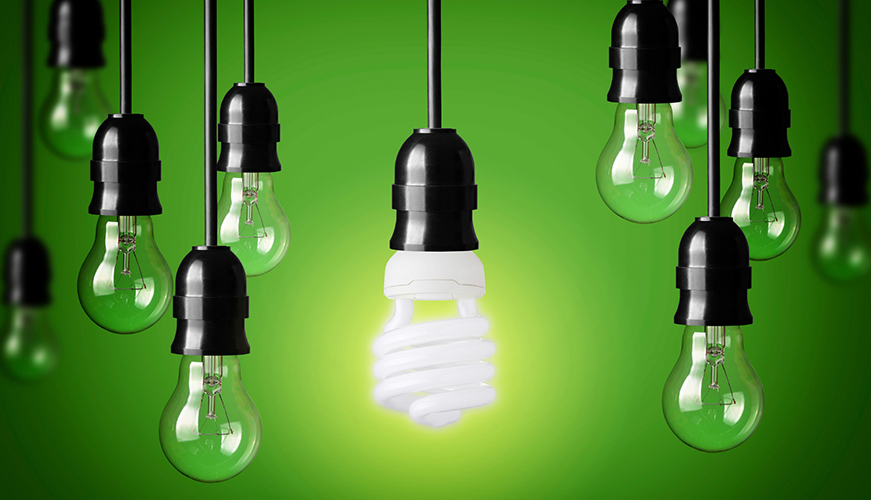We all know what we’re supposed to do to be good, environmentally conscious citizens: recycle, don’t waste water, turn off the lights, etc. But what exactly is at stake when we try to “go green?” As stories of environmental disaster spread across the globe, from China’s toxic smog to the oil spills that pollute our water and destroy wildlife, it’s becoming painfully clear that something must be done soon if we want to continue living in a healthy, vibrant world. Scientists say that carbon dioxide (CO2) is responsible for all kinds of environmental damage, and in the United States, the largest source of CO2 emissions comes from the generation of electricity. If we want to make an impact, we should make changes where it matters most.
Most people would like to be more eco-friendly, but they don’t follow through because “green technologies are expensive.” In reality, though, the cost difference is usually minimal, and green technologies can actually help you save money by using less electricity. In this post, we will show you five energy saving products that will improve the energy efficiency of your home, reduce your carbon footprint, and help you save money on your utility bills.
1. SMART THERMOSTATS
Climate control is crucial to staying cozy in the winter and cool in the summer, but it is also a huge drain on your finances. Heating and air conditioning make up almost 50% of the average household’s energy use each year. One way to reduce this cost is by installing a smart thermostat such as those made by Nest, Honeywell, or Ecobee. These devices will learn your family’s needs and adjust the temperature accordingly, saving you money by cutting out unnecessary energy expenditure.
Another option is a programmable thermostat, which allows you to set the temperature patterns yourself. You can program these to use less energy while you’re asleep or away from home.
By using your heating and cooling efficiently, you can keep your house comfortable while saving up to $180 per year in energy costs.
2. ENERGY SAVING LIGHT BULBS
One of the easiest, fastest, and least expensive ways to conserve energy is by replacing your traditional light bulbs with energy saving light bulbs such as halogen bulbs, compact fluorescent lamps (CFLs), and light emitting diodes (LEDs). LED bulbs are the most efficient option if you want the brightest light for the least amount of energy. Most people who make the switch report great results and see an immediate impact on their electricity bill. If you remain unconvinced, here are some straightforward figures for you:
- Energy saving light bulbs typically use about 25%-80% less energy than incandescent bulbs
- CFL bulbs last 6 times longer than traditional bulbs, and LED bulbs can last more than 20 times longer
- Only 10% of the energy used by incandescent bulbs actually turns into light (the rest is wasted on heat), whereas LED lights have effective heat management and minimize wasted energy
What about the higher price? It’s true that energy saving light bulbs are more expensive than regular light bulbs, but they compensate for the price with a longer life span (which also means fewer trips to the supermarket to buy new ones). They use a fraction of the energy that incandescent bulbs use to produce the same amount of light. Plus, they come in every color imaginable, so you can add some fun to your house, apartment, or workplace.
3. HOME ENERGY MONITOR
If you don’t know why your electricity bill is so high, it might be because you don’t know how you are using energy. Thankfully, modern technology allows you to track your electricity usage with a home energy monitor. These machines give you real-time information about your household’s electricity use in either kilowatts or dollars. Various studies have shown that you can reduce your home energy use by 4 – 15% when you use a home energy monitor. One of the biggest benefits of this technology is that you can react directly to whatever is causing you to spend unnecessary money, so the return on investment for these monitors is almost immediate. As soon as you see the data, you can start saving money and helping the planet.
4. ENERGY MANAGEMENT SYSTEMS
While these are usually designed for big buildings or businesses, the market has seen a rise in energy management systems for residences as well. This type of technology lets you manage heating and lighting in different areas of your house, and is usually simple enough for the user to set up without the help of a contractor.
With an energy management system, you can control the energy use of your entire home with your smartphone or a remote control. This allows you to lower or turn off heat, lighting, and appliances while you’re away so that energy is not wasted on an empty house. Maximum efficiency reduces energy consumption, which subsequently reduces your energy bills and CO2 emissions.
An energy management system can be a more expensive option than a home energy monitor, but it’s a solid choice if you don’t have the ability to constantly check your energy consumption, you’re not sure how to do it, or you just don’t want the hassle of keeping up with it.
5. LIGHTING CONTROL SYSTEMS
It’s obvious that you can save energy by turning off lights when they’re not needed, but sometimes we don’t even notice that we’ve left them on. For those cases, lighting control systems offer a solution when you forget to turn them off yourself.
Lighting controls can be used to turn indoor and outdoor lights on and off at specific times. There are two types of timers: manual timers, which plug into an electrical outlet for controlling devices such as lamps or light strings; and in-wall programmable digital timers, which look like digital thermostats and make indoor or outdoor lighting automatic.
You can also choose to get a lighting control system with motion sensor controls. These will automatically turn lights on when motion is detected and off when it isn’t.
These technologies work perfectly with LED and CFL lights, so you can use both to double up on your savings.
To make these options even more affordable, your landlord may be willing to deduct the price of these improvements from your rent because your eco-friendly decisions are adding value to the property. Go ahead and ask! Regardless, these energy saving products should pay for themselves as they cut down on both your electricity bill and your carbon footprint.



